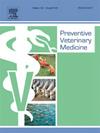无prrs地区早期检测监测的量化
IF 2.2
2区 农林科学
Q1 VETERINARY SCIENCES
引用次数: 0
摘要
2022年5月,丹麦启动了一项针对猪繁殖与呼吸综合征病毒的国家控制规划,首批地区正在接近无猪繁殖与呼吸综合征状态。因此,现在的问题是应如何进行监测,以便尽早在无PRRS地区发现新的PRRS病毒入侵。本研究的目的是在区域一级量化丹麦现有的和备选的PRRS监测系统的早期发现敏感性。目前的PRRS监测系统由应通报的监测部分和主动血清学监测部分组成,包括每月抽样(繁殖和倍增器养殖场)或每年抽样(生产养殖场)。本研究的结果估计,目前的监测系统检测到PRRS入侵无PRRS区域的最小概率为21.5 %[16.0 %;32.4 %]。如果每个月在所有农场采集血清样本,则概率将增加到87.7 %[87.4 %;88.6% %]min;max。症状监测组件添加到现有的监测系统导致的早期检测灵敏度23.9 %(17.6 %;34.6 %)分钟,马克斯,而有针对性的基于风险的概率抽样导致27.8 %(17.9 %;33.8 %)分钟,马克斯和62.6 %(17.9 %;79.5 %)分钟;最大季度或月度抽样频率,分别。本研究的结果表明,在目前的监测系统下,在无prrs地区的第一个月内发现新感染猪场的机会相对较低。可以通过增加所有养殖场的采样频率或采用有针对性的基于风险的采样来增加早期发现PRRS的可能性。本文章由计算机程序翻译,如有差异,请以英文原文为准。
Quantification of early detection surveillance in PRRS-free regions
In May 2022, a national control program targeting porcine reproductive and respiratory syndrome virus was launched in Denmark, and the first regions are approaching a PRRS-free status. Hence, the question now arises as to how the surveillance should be performed to identify new incursions of the PRRS virus in PRRS-free regions as early as possible. The aim of the present study was to quantify the early detection sensitivity of the current and alternative PRRS surveillance systems in Denmark at a regional level. The current PRRS surveillance system is composed of a notifiable surveillance component and an active serological surveillance component, consisting of monthly sampling (breeding and multiplier farms) or yearly sampling (production farms). The results from the present study estimated that the current surveillance system would have a 21.5 % [16.0 %;32.4 %]min;max probability of detecting an incursion of PRRS into a PRRS-free region. If monthly serum samples were taken on all farms, the probability would be increased to 87.7 % [87.4 %;88.6 %]min;max. Adding a syndromic surveillance component to the existing surveillance system resulted in an early detection sensitivity of 23.9 % [17.6 %;34.6 %]min;max, while targeted risk-based sampling resulted in probabilities of 27.8 % [17.9 %;33.8 %]min;max and 62.6 % [17.9 %;79.5 %]min;max for quarterly or monthly sampling frequencies, respectively. Results from the present study indicate a relatively low chance of detecting newly infected farms within the first month in a PRRS-free region with the current surveillance system. The probability of early detection of PRRS can be increased either by increasing the sampling frequency on all farms or by using targeted risk-based sampling.
求助全文
通过发布文献求助,成功后即可免费获取论文全文。
去求助
来源期刊

Preventive veterinary medicine
农林科学-兽医学
CiteScore
5.60
自引率
7.70%
发文量
184
审稿时长
3 months
期刊介绍:
Preventive Veterinary Medicine is one of the leading international resources for scientific reports on animal health programs and preventive veterinary medicine. The journal follows the guidelines for standardizing and strengthening the reporting of biomedical research which are available from the CONSORT, MOOSE, PRISMA, REFLECT, STARD, and STROBE statements. The journal focuses on:
Epidemiology of health events relevant to domestic and wild animals;
Economic impacts of epidemic and endemic animal and zoonotic diseases;
Latest methods and approaches in veterinary epidemiology;
Disease and infection control or eradication measures;
The "One Health" concept and the relationships between veterinary medicine, human health, animal-production systems, and the environment;
Development of new techniques in surveillance systems and diagnosis;
Evaluation and control of diseases in animal populations.
 求助内容:
求助内容: 应助结果提醒方式:
应助结果提醒方式:


